How to Identify Wild Raspberries, Blackberries and Related Wild Berries
- Authors
- Name
- Sam Sycamore
- @tanoaksam
- Published on
- Last updated
Table of Contents
- What are wild brambleberries?
- Are wild raspberries and blackberries edible?
- Key characteristics
- Etymology and taxonomy
- Common names
- Taxonomical lineage
- About the Rubus genus
- Where to find wild raspberries and blackberries
- When to gather wild raspberries and blackberries
- Why forage for wild raspberries and blackberries?
- How to harvest and prepare wild raspberries and blackberries
- How to sustainably work with wild raspberries and blackberries
- Raspberry and blackberry lookalikes
- Poison ivy and poison oak
- Mulberry
What are wild brambleberries?
Brambleberries are the quintessential summertime berries. Blackberries, raspberries and related regional species from the Rubus genus are some of the only wild fruits still held in high regard by modern North American culture.
Brambles grow from perennial rhizomes and produce thickets of unmistakable cane stems, almost always thorny, which bear bright, shiny, delicious clusters of berries that ripen across a color spectrum of yellow, orange, pink, red, maroon and deep purple.
Are wild raspberries and blackberries edible?
Yes. Berries, leaves, and young shoots are edible.
Key characteristics
- thorny trailing stems (canes) usually growing in thickets along woodland edges
- black raspberry canes are smooth and pink-purple-blue with noticeable bloom present (like the skin of a blueberry)
- wineberry canes are bright red with fuzzy, hairy thorns
- blackberry canes are green to red-brown, sometimes as a result of sun exposure, and often have the woodiest thorns;
- Himalayan blackberries will be especially thick and robust
- thimbleberry canes are perennial and thornless
- palmately compound leaves with 3 or 5 (rarely 7) leaflets
- white 5-petaled Rosaceae flowers in spring and summer
- unmistakable bramble fruits
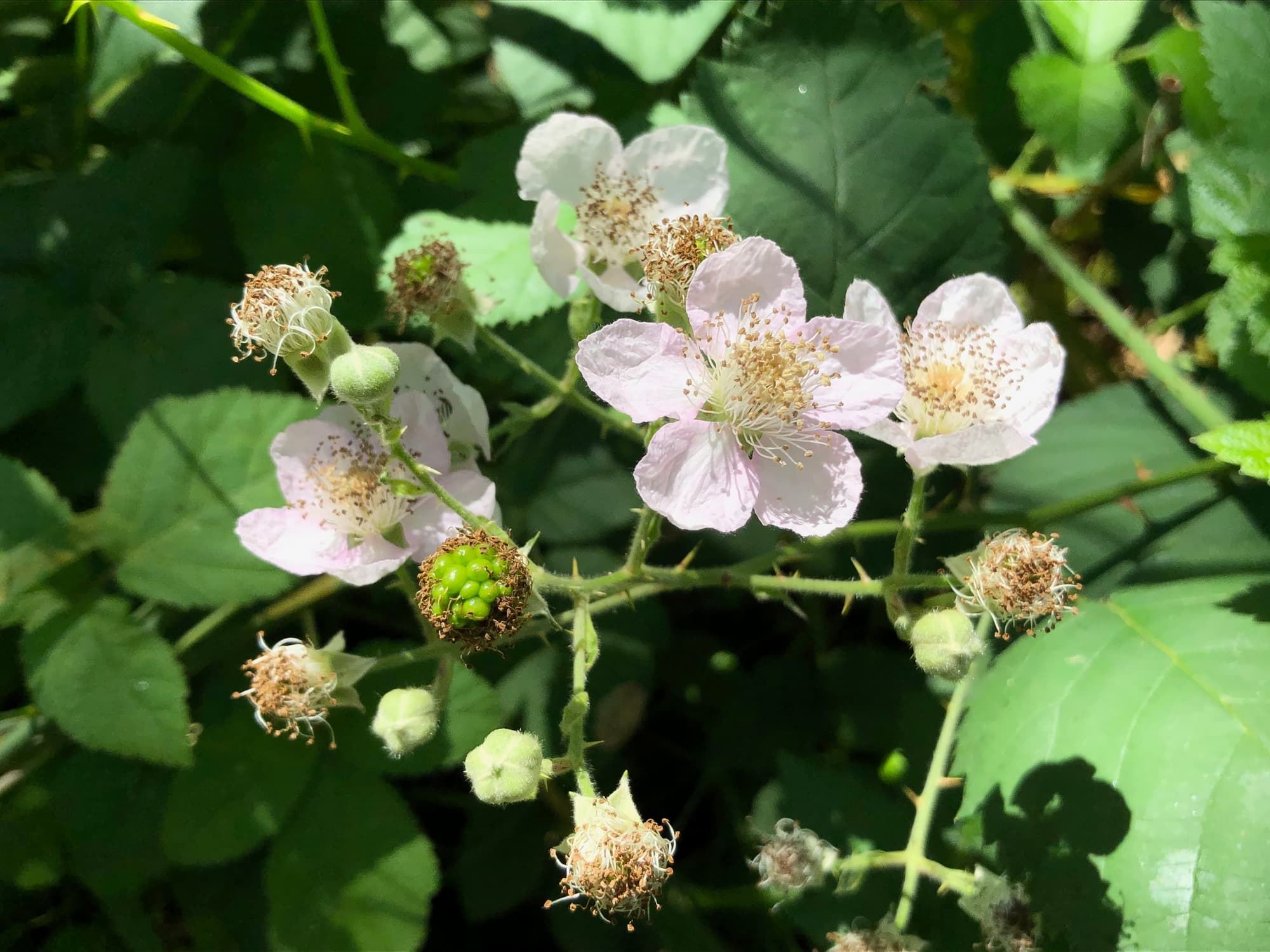
Despite their differences, nearly all Rubus species have very similar flowers that give them away as members of the Rosaceae family.
Etymology and taxonomy
Common names
Blackberries, raspberries, black raspberries, black caps, wineberries, dewberries, salmonberries, thimbleberries, cloudberries, etc.
Taxonomical lineage
Source: Wikipedia
About the Rubus genus
The Rubus genus boasts anywhere from 250 to 700 species, depending on who you ask—members of the Rosaceae family readily hybridize with one another, blurring the lines between distinct species.
Rubus has a worldwide distribution across a range of climates and ecosystems, but is most diverse and abundant in the Northern Hemisphere.
Common native North American species include the blackberries (many species), black raspberries (R. occidentalis in the east and R. leucodermis out west), salmonberry (R. spectabilis), thimbleberry (R. parviflorus), and the red raspberry (R. idaeus), as well as the invasive Himalayan blackberry (R. armeniacus) and wineberry (R. phoenicolasius).
Rubus spp. are unique for their biennial canes (more on this later) and their compound fruits: what we think of as "the" fruit is actually an aggregate cluster of many small berries called drupelets.
The main trait that distinguishes blackberry-type fruits from raspberries is the presence (or absence, respectively) of the flower receptacle in the ripe fruit. The receptacle remains inside of the blackberry when you pick it from the stem; with raspberries, the receptacle stays behind on the flower stem, giving the fruit its hollowed-out dome shape—hence why black raspberries are also known as black caps.
Where to find wild raspberries and blackberries
North America is home to 100 or more Rubus species, most of which tend to thrive on woodland edges. We also commonly encounter a few invasive species which can become persistent weeds in disturbed and marginal spaces, and which sometimes outcompete their native counterparts who occupy those edge niches.
The distribution of Rubus spp. in North America reveals different groups of species found in each of three broad regions: first is the eastern half, as far as the Rocky Mountains; next is the west coast, from California up to Alaska; and finally comes the northern/mountainous group encompassing the U.S. Rockies as well as most of Canada.
Local varieties of blackberries, dewberries, and bristleberries, as well as the invasive Himalayan blackberry, will be found across all three regions, though absent from Canada beyond the southernmost edges of the coasts.
Two nearly identical species of black raspberries are found on both sides of the U.S., genetically isolated from one another by the Rockies.
The east is also home to the native purple-flowered raspberry (R. odoratus) and the vigorous invasive wineberry.
The thimbleberry is found on the west coast and all through the Rockies, while the salmonberry is unique to the Pacific Northwest.
The red raspberry, arctic raspberry (R. arcticus), and cloudberry (R. chamaemorus) are restricted to the northern half of the continent.
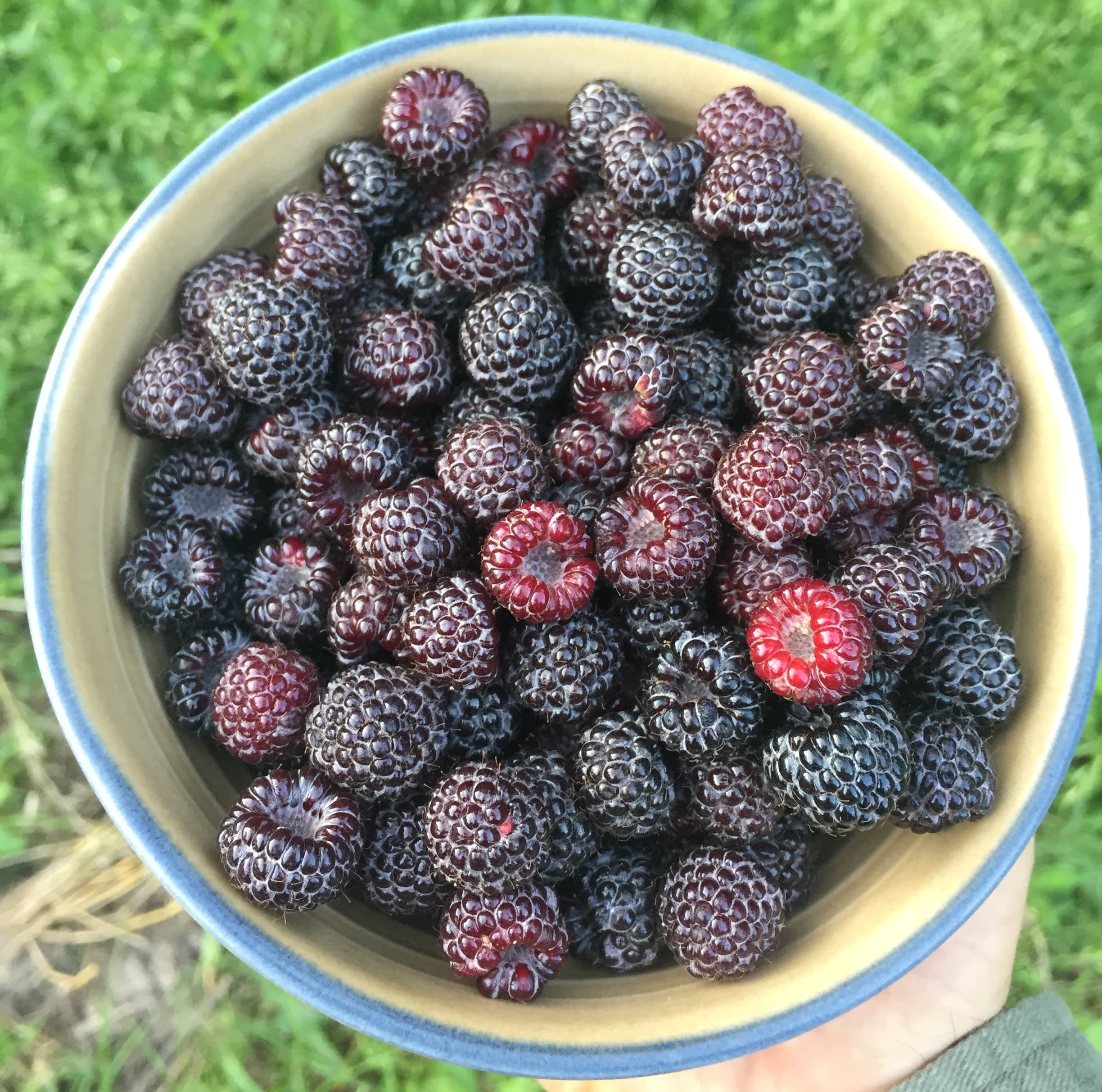
Freshly harvested black raspberries in early summer.
When to gather wild raspberries and blackberries
In most climates, new canes will begin to emerge in March and April, and flowers will appear on the new branches of second-year canes shortly thereafter.
If you play your cards right, you can harvest brambleberries for at least two months each summer, beginning sometime in June for the hottest climates and ending in late August for the cooler climates.
Each species on your local landscape will produce berries within a 2- to 6- week window, with a fair amount of overlap between species. For example, in my home state of Kentucky, late June's black raspberries are followed by mid-July's wineberries and early August's blackberries.
Why forage for wild raspberries and blackberries?
Along with bananas, apples, and mangoes, brambleberries are one of those quintessential "human foods"—when you interact with these plants and the food that they provide for us, it sometimes feels like there's intention there, like they're producing these fruits specifically for us.
Bright, shiny, colorful, sweet, nutritious berries hanging at or near human eye level...
Coincidence?
Think about it, that's all I'm saying.
Brambleberries are among the most abundant fruits we can harvest all summer long. They're generally easy to track down, unmistakable to identify, and because any given region is home to multiple species with variations in seasonality, you can potentially ride the Rubus wave for months each year if you're diligent.
It's a no-brainer to devote a serious amount of your annual foraging time to the blackberries and their ilk. You could easily gather a year's supply of fruit from these species alone each summer.
How to harvest and prepare wild raspberries and blackberries
I hate to say it, but I don't think there's any way around this: you're gonna have to get in there—yes, right in the thick of it, thorns, mosquitoes and all—and pluck each and every one of those ripe berries individually, by hand. It may be an exercise in patience, but believe me, it's well worth every moment. Durable long sleeves and foraging companions with a high tolerance for pain can make all the difference!
Some species will produce clusters of berries that ripen all at once, while others will roll out slowly over several days. You will want to visit a single patch multiple times across the weeks to take advantage of each successive round of ripening. Keep in mind that you'll be competing with birds and other berry-loving critters who are usually less picky than you when it comes to what's considered "ripe enough."
As for culinary uses, I should hope you already know what to do! Jams, jellies, pies, smoothies, muffins, cakes, fruit leather, ice cream, wine... the list goes on.
Because of the irregular timing for ripe berries—and the speed with which they perish—I usually toss my freshly picked berries straight into the freezer unless I'm planning to eat them that day or the next. For quick processing in the absence of a freezer, I mash them up and dry into a fruit leather.
Young shoots of Rubus species may be eaten raw, peeled, or lightly sautéed. Sam Thayer (Incredible Wild Edibles, 2017) says salmonberries and black and red raspberries are the best tasting.
Young leaves may also be gathered and dried to make a somewhat astringent medicinal tea that is used to help relieve diarrhea and digestive issues, but you may find it pleasant to sip on when feeling fine, too. Traditionally the leaves would be bruised and fermented like other tea leaves, but this extra processing is not necessary.
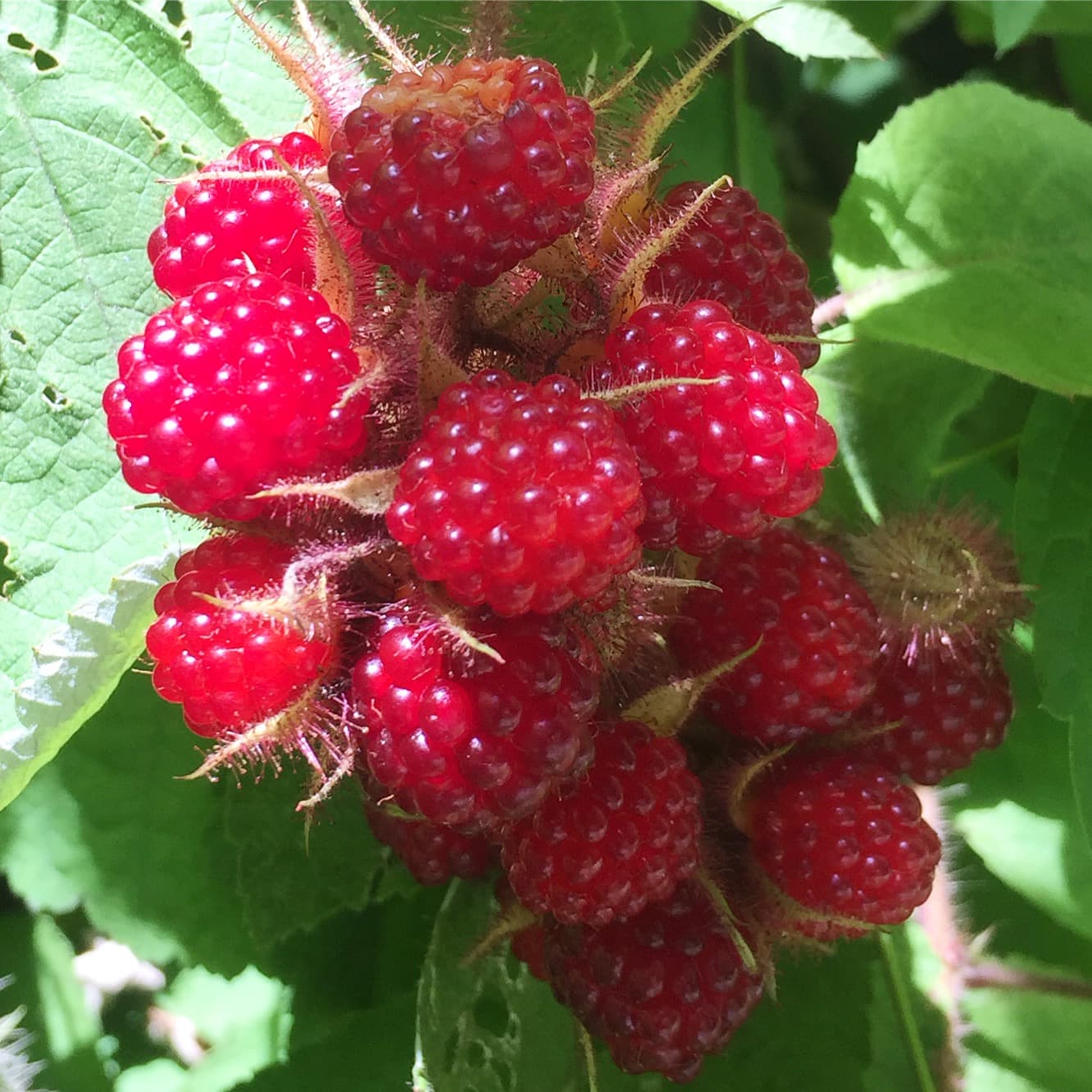
Wineberries are some of the most beautiful and delicious berries I've ever encountered.
How to sustainably work with wild raspberries and blackberries
Not only are you not harming the plants by gathering their berries, but in the case of our Rubus allies, I firmly believe that they want us to eat them!
Don't be afraid to really get in there and stomp on the canes as you're harvesting—more often than not, those stems will sprout new roots everywhere they make contact with the ground, which is one of their primary reproductive strategies. (See? They want you to trample them!)
Humans have probably understood this for countless millennia—well before the advent of agriculture—and mimicked this natural process in order to intentionally propagate their favorite brambles.
Surprisingly, though, brambleberries have only been domesticated very recently in agricultural history. Maybe nobody felt the need to cultivate them because they are so naturally abundant?
Propagating brambleberries is a really fun and easy way to learn the basics of perennial plant propagation, but before we explore the different ways to pull it off, we need to look a little deeper into the life cycle of your average Rubus.
While it's true that a bramble's roots are perennial, its individual canes behave like biennials, so they grow through their vegetative phase in year one (when they are known as primocanes) and then flower and produce fruit in year two (then called floricanes) before dying back, after which they may hang around as dry, brittle, thorny debris for many seasons to come.
When propagating, we are only interested in the first-year primocanes, not the fruiting floricanes, because in year two those canes are no longer interested in vegetative growth and so they won't produce new roots for us.
How can we tell the two apart? Primocanes are tender new stems shooting straight up from the plant's roots; floricanes are woodier and noticeably more mature, and they will sprout reproductive shoots from their axillary buds as the season goes on. Don't lets those flowering shoots fool you into thinking they are primocanes—a primocane will always emerge directly from the soil, not from the node of a woody cane.
When we've identified some primocanes we like, we have two options for propagating:
- layering
- taking cuttings
If this is a patch that you can return to in a month or two to check on, layering will usually provide a more reliable and robust clone.
To do this, locate a primocane that is a couple feet long and perhaps already bending downwards.
Carefully bend the actively growing stem so that one or more of its nodes makes contact with the ground, and loosely cover with soil. Then gently place a heavy stone or log on top to pin it down, taking care not to totally crush it.
This stem will magically transform from aboveground to belowground growth and sprout new roots at those nodes, generally within just a few weeks. Once these roots are well established, which could take a bit longer, you may cut the cane to separate the clone from its parent plant, dig up its roots and transplant.
Black raspberries take to this method especially well, but all brambles (and many other perennial plants) can be propagated in this way.
If you're just passing through and you identify some specimens you want to take with you, you can grow new plants later by taking cuttings today.
Seek out those same actively growing stems you would layer and instead cut with bypass pruners at roughly six-inch lengths, making sure to leave a minimum of 4-5 nodes on each cutting. Remove the leaves from the bottom couple of nodes, being careful not to damage the axillary buds.
Stick your cuttings in a soil-free potting medium (this will usually be a mix of peat moss or coco coir, perlite, and compost, readily available at any garden supply store) with at least two nodes below the soil and two above.
Keep them warm, humid and moist for the next few weeks, and don't stress if some or all of the foliage dries up—but this is likely a sign that your cuttings want to be misted more frequently. Pretty soon you'll start to see new growth at the nodes, and possibly new shoots rising from below the soil.
Your success will depend on the individual species and specimens you're working with, along with the conditions you're able to provide, but this is largely a numbers game—plan for a very conservative 25% success rate if you're new to this. (But I will mention that I took three black raspberry cuttings earlier this year, pictured throughout this profile, and all three have rooted for me without much effort at all.)
A note on accidental propagation: unlike many other berry seeds, the seeds of the invasive wineberry actually do remain viable after they pass through the human gut. Keep this in mind if duty calls in the woods after you've recently gorged yourself on wineberries, or if you compost your "humanure."
Much ado is made about the invasive nature of the wineberry and the Himalayan blackberry, but in my opinion these are clear cases where we can't beat 'em, so we might as well eat 'em!
Thankfully, they are two of the most delicious and plentiful berries on Earth, so while I would not advocate propagating them—trust me, they don't need your help—I certainly would not worry about trying to kill them.
Raspberry and blackberry lookalikes
Poison ivy and poison oak
Species in the Rubus genus may bear a passing resemblance to some of the dreaded Toxicodendron spp., better known as poison ivy and poison oak. All are creeping woodland vines with palmately compound leaves. But the Toxicodendron spp. will never have thorns, and though their leaves may be notched or lobed, they will not have serrated toothy margins like the brambles. And of course poison ivy and poison oak do not produce anything like the Rubus berry.
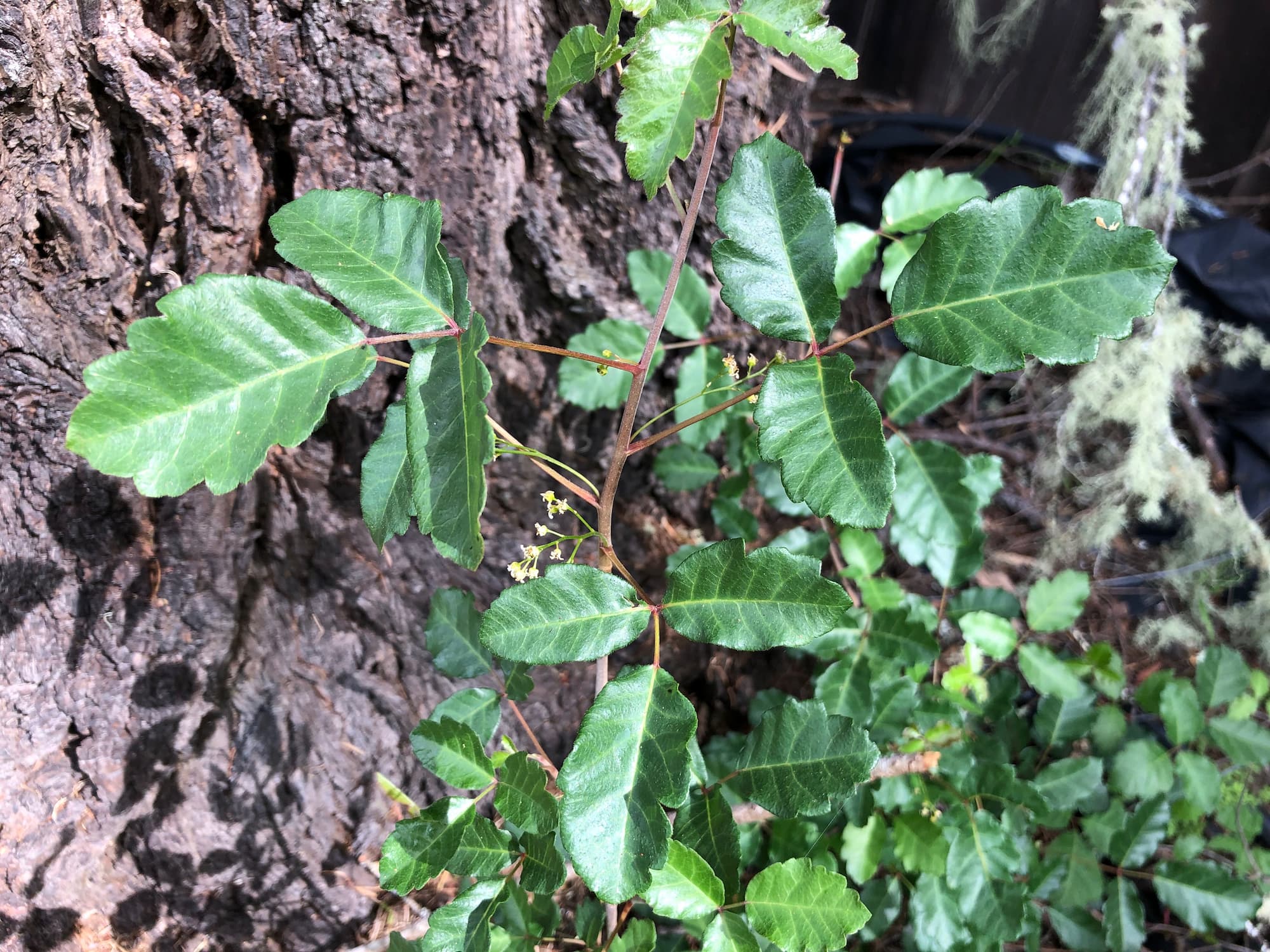
Poison oak leaves may appear superficially similar to those of the Rubus genus, but a closer look at the rest of the plant makes it obvious that it should be avoided.
Mulberry
Only the mulberries (Morus spp.) produce fruits that looks like blackberries, and they are also edible.
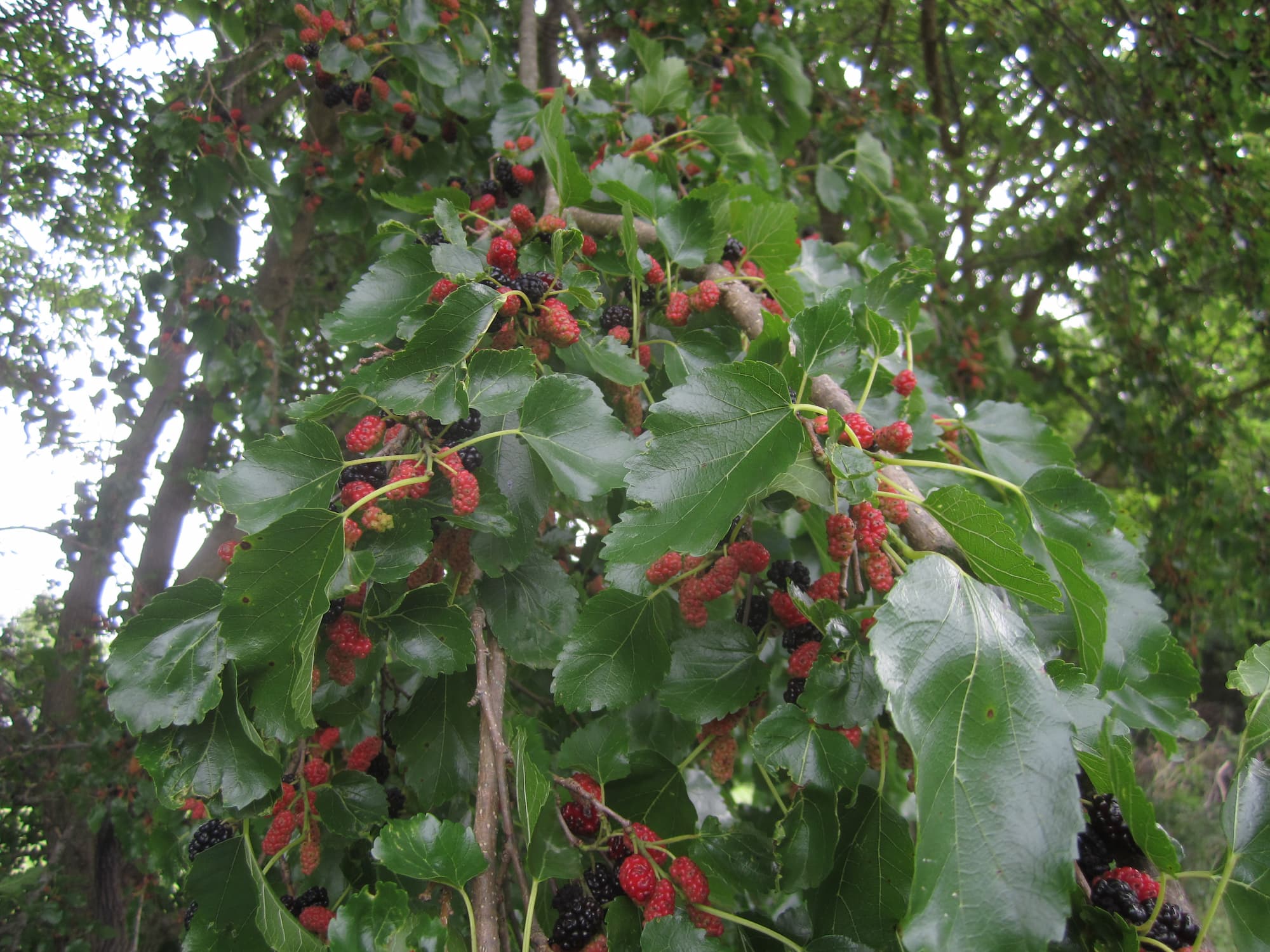
Blackberry canes can grow large, but never as large as a mulberry tree—and the lack of thorns is a dead giveaway. Still, not a bad find!
Click here to learn more about mulberries.
Foraging North America
Did you find this article helpful?
This is an excerpt from Foraging North America: The Botany, Taxonomy and Ecology of Edible Wild Plants.
Foraging North America is a 12-week crash course designed to arm you with a functional working knowledge of botany and taxonomy that you can take with you out onto the land to fast-track the ID process and boost your confidence when gathering wild foods for the first (or five-hundredth!) time.
You'll get a practical education in ecological literacy by applying the ethos of conservation through use—the (surprisingly) radical notion that humans can, in fact, have a positive impact on the environments that we move through.
Food is everywhere—you just need to know what to look for!